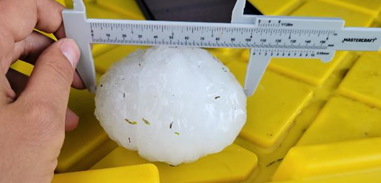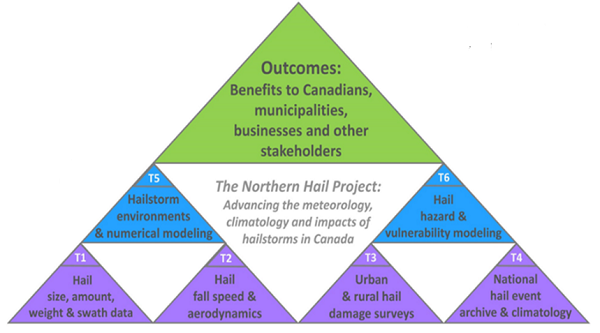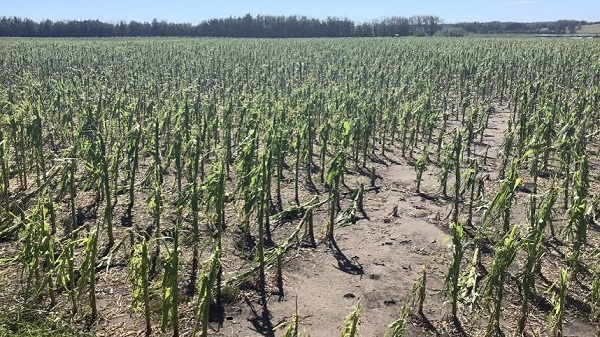About the Northern Hail Project
Why the Northern Hail Project (NHP)?
 Hail has been identified as the largest contributor to insured losses from severe convective storms (SCS) globally. Over the past decade, impacts from hail and tornadoes have averaged about $20 billion in insured losses annually around the world, with an abrupt and significant increase observed in the past decade. In June 2020, Calgary experienced Canada’s first billion-dollar hailstorm and fourth costliest natural disaster in Canadian history, with insured losses of $1.2 billion.
Hail has been identified as the largest contributor to insured losses from severe convective storms (SCS) globally. Over the past decade, impacts from hail and tornadoes have averaged about $20 billion in insured losses annually around the world, with an abrupt and significant increase observed in the past decade. In June 2020, Calgary experienced Canada’s first billion-dollar hailstorm and fourth costliest natural disaster in Canadian history, with insured losses of $1.2 billion.
Of all precipitation types related to SCS, hail is the least understood. This is attributable to an incomplete understanding of certain key hail-growth processes. Unfortunately, it has been almost four decades since the last dedicated hail research program in Canada ended, with the result that there is a significant gap in high-quality and high-resolution data for both storms and hail. This data gap is the bottleneck in advancing hail research, which is critical for improving forecasts, impact assessments, and cost-effective mitigation strategies. Since the last hail research program ended, there have been major technological advances that the NHP can now adopt to advance hail science.
Together with the Northern Tornadoes Project and the new Northern Mesonet Project, the Northern Hail Project falls under the umbrella of the Canadian Severe Storms Laboratory, which undertakes the collection of data, documentation of events, and pursuit of research that enhances our understanding of severe convective storms and their impacts, and allows the development of innovative techniques and tools.
The Northern Hail Project Objectives

The main objective of the proposed joint project between NSERC Alliance – Mitacs Accelerate and NHP, in partnership with the Institute for Catastrophic Loss Reduction (ICLR) and others, is to address the key data and knowledge gaps for hail. In order to, ultimately, improve the means for managing our risk and vulnerability to hail, we must advance our understanding of hail occurrence and impacts across Canada.
These objectives will be realized through the following tasks:
- Capture meteorological data associated with the occurrence of SCS and associated damaging hail (and wind-driven hail) events using a wide range of collection methods and instruments, including hail monitoring equipment, radar data, and field work;
- Understand the aerodynamics of hailstones and its effect on fall speed;
- Develop remote sensing and on-the-ground methods to conduct advanced hail damage assessments and field surveys, to determine impacts to the built (buildings and other infrastructure) and natural (crops, trees and forests) environments;
- Identify and categorize all damaging hail events in Canada by integrating new data sources (including social media) to develop an observation-based hail climatology;
- Better understand hailstorm environments, and in collaboration with Environment and Climate Change Canada, improve numerical models for forecasting, ‘nowcasting’ (forecasts out to one hour), and issuing warnings for damaging hail; and
- Develop damaging hail hazard, vulnerability, and catastrophe models for Canada.
Investing in tomorrow’s scientists

There is a dearth of Canadian meteorologists, engineers, and risk modelers with expertise in forecasting, assessing, and modeling the SCS that produce damaging hail.
If funding is approved, the NHP will train 55 Highly Qualified Personnel (HQP), consisting of 1 postdoctoral fellow (PDF), 10 PhD students, 7 MSc students, and 37 summer research interns, offering them the hands-on experience needed to change this situation. High Qualified Personnel will be involved in the operation of the equipment and its deployment and gain valuable data analysis and coding skills. Collectively, they will also acquire multi-disciplinary capabilities and experiences that position them for future opportunities dealing with extreme weather and its impacts.
Benefits to Canada and Canadians

The proposed research will have several significant benefits for Canada as well as internationally.
Obtaining detailed data for damaging-hail events over both agricultural land and urban areas will help researchers and stakeholders mitigate damage potential from this hazard. We will learn about how infrastructure performs and how people and crops are affected by hail, including how adverse impacts could be mitigated through proactive approaches. This will support the development of more resilient communities and infrastructure systems.
Our improved understanding of how hailstorms form will allow the development of improved warning systems. Additionally, the improved event climatology generated by our research will improve risk and catastrophe models for the insurance sector and design professionals, as well as support the mitigation of risk to renewable energy infrastructure that is sensitive to hail (i.e., solar and wind power).
